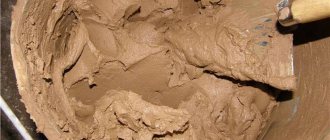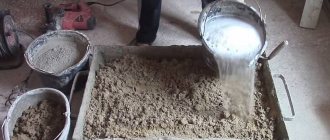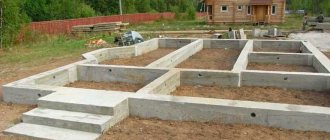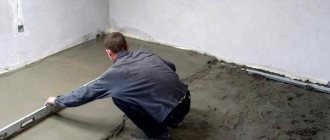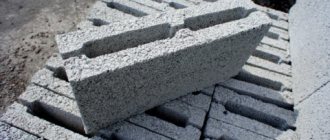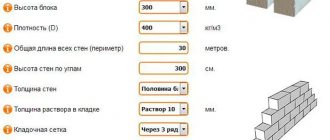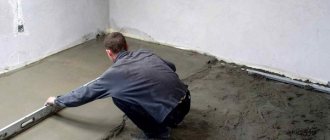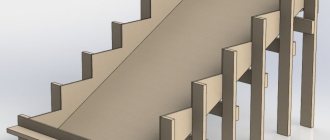Concrete calculator for a foundation in the form of a monolithic slab
Calculation of materials for a slab foundation
When planning to concrete a monolithic slab, developers are faced with the problem of how to calculate the amount of concrete for the foundation.
The calculator allows you to quickly determine the consumption of concrete mixture after entering the following parameters into the appropriate columns of the program:
- length of the slab base;
- width of the foundation slab;
- height of the reinforced concrete base.
By performing calculations manually, you can neglect the volume occupied by the reinforcement cage. You just need to multiply the dimensions of the structure and get its volume, which approximately corresponds to the need for concrete composition. To obtain accurate values, it is necessary to use software methods.
Tile foundation.
A slab foundation is a monolithic structure poured under the entire area of the building. To make the calculation, you need basic data, that is, area and thickness. Our building measures 5 by 8 and its area will be 40 m2. The recommended minimum thickness is 10-15 centimeters, which means when pouring the foundation we need 400 m3 of concrete.
The height of the main slab is equal to the height and width of the stiffener. This means that if the height of the main slab is 10 cm, then the depth and width of the stiffener will also be 10 cm, it follows that the cross section of a 10 cm rib will be 0.1 m * 0.1 = 0.01 meters, then multiply the result by 0.01 m, for the entire length of the rib 47 m, we obtain a volume of 0.41 m3.
Slab base
A slab foundation is one of the types of shallow foundations that is used in low-rise construction in the case of complex soils, for example, heaving or unevenly settling. It is a monolithic rectangular or square slab with a thickness of 0.3 to 0.5 m.
To calculate a cube of concrete, it is enough to find the product of the following quantities:
- width;
- length;
- height.
Slab
To calculate the cubic capacity of concrete for this type of foundation, the total volume of the slab is determined. This will be the desired value and is equal to the product of the area of the slab base and its thickness.
The area of a cottage 8x10 meters is 80 sq.m. For example, the thickness of the slab is 25 cm. Thus, the mixture consumption will be:
(80 sq.m) x (thickness: 0.25 m) = 20 cubic meters.
When making calculations, it is important to take into account the weight of the building. For heavy loads, you need to either increase the thickness of the slab or add stiffeners
They are made on load-bearing walls (including internal ones), or they are formed into square cells ranging in size from 1.5 m to 2 m - this depends on the operating conditions. In the second case, the slab has increased rigidity and strength.
The filling of the stiffener structure will be an additional value that is added to the total flow rate and is determined as follows:
(cross-sectional area of the stiffener) x (total length of the ribs).
Slab
The amount of concrete for the foundation of a slab structure is calculated from the thickness of the structure from 0.1 m (the thickness is determined at the design stage based on the soil parameters and the characteristics of the building). For example, for a residential building or office space measuring 8*10 m, you will need to order and deliver at least 8*10*0.25=20 m³ of the mixture.
The formula is correct for slabs of a flat configuration, but when arranging trapezoidal stiffeners (directed upward or downward), additional material must be taken into account.
An approximate algorithm for calculating the need for mortar when arranging a slab-type foundation:
- Determine the volume of the flat base, taking into account the area and thickness of the slab.
- Calculate the volume of each trapezoidal reinforcement beam, which is determined by the formula V=S*L (where S is the cross-sectional area and L is the length of the rib). To determine the area, the equation S=H*(A+B)/2 is used, where H is the height of the edge of the figure, and A and B are the length of the bases of the geometric figure.
- Determine the volume of all reinforcing elements, and then calculate the total volume. Since loss of solution is possible during transportation or pouring of the base, it is recommended to introduce a correction factor of 1.05 into the calculations. Based on the obtained measurements and coefficients, the developer can calculate how much concrete will be needed to construct a flat foundation.
For example, the owner needs to determine how much concrete is needed for the foundation of a house measuring 10 by 10 m, which has 6 reinforcements in the form of an isosceles trapezoid with a height of 200 mm and bases of 300 and 100 mm. At the first stage, the amount of mixture for a flat slab 10*10*0.1 m=10 m³ is determined.
Then the volume of the beam is calculated using the formula 10*0.2*(0.3+0.1)/2=0.4 m³, but for 6 amplifiers you will need 6*0.4=2.4 m³. The total costs of the cement-sand mixture for the foundation are equal to (10+2.4)*1.05=13.02 m³.
Obtaining data using online calculators
Since calculating a power structure is a rather labor-intensive process, the task can be partially simplified by using specialized services and online calculators.
Among all existing sites, the following portals are most popular:
moi-domostroi.ru is a simple house weight calculator. To make the calculation, you will need to know the shape of the house, the dimensions of all structural elements, types of building materials, type of roof, and specify the region.- gvozdem.ru is a service for determining the number of support elements. Allows you to find out the need for concrete and reinforcement, knowing the parameters of the pile.
- screw-piles.ru is a service for determining the need for piles based on the design features and soil type.
All freely available programs use average conditions and approximate coefficients, so the results of such calculations can only be used for preliminary planning.
Concrete: buy or make it yourself?
The composition of concrete includes:
- Portland cement or slag binder;
- Sand;
- Crushed stone, better enriched;
- Plasticizers;
- Water.
You can prepare the solution yourself, but first you need to calculate the total volume - still, pouring must be done continuously and evenly. One of the options for replacing factory supplies is renting or purchasing a concrete mixer.
How to calculate the amount of cement for the foundation
The amount of cement depends on the type of concrete used. In private housing construction, concrete M300 or M400 is mainly used for the foundation. This strength is sufficient to ensure reliable and durable service of the structure.
Calculation of cement for the foundation can be done using the table of proportions:
| Concrete grade | Proportions of components C: P: Shch | Volumetric composition of cement per 10 liters of cement, l | How much concrete will be produced from 10 liters of cement, liters |
| For cement M400 | |||
| 200 | 1 : 2,8 : 4,8 | 25 : 42 | 54 |
| 250 | 1 : 2,1 : 3,9 | 19 : 34 | 43 |
| 300 | 1 : 1,9 : 3,7 | 17 : 32 | 41 |
| 400 | 1 : 1,2 : 2,7 | 11 : 24 | 31 |
| For cement M500 | |||
| 200 | 1 : 3,5 : 5,6 | 32 : 49 | 62 |
| 250 | 1 : 2,6 : 4,5 | 24 : 39 | 50 |
| 300 | 1 : 2,4 : 4,3 | 22 : 37 | 47 |
| 400 | 1 : 1,6 : 3,2 | 14 : 28 | 36 |
How much cement is needed for the foundation will be known after determining the entire volume of the supporting structure. It is worth remembering that there are 1000 liters in 1 cubic meter. Accordingly, if the calculation of the amount of M300 concrete showed 7 m3, and we had M400 cement at our disposal, we make a translation:
Proportionality line – 1: 1.9: 3.7 (C:P:SH). The figures are given in units of your choice (kilogram, liter). The bulk density of cement is 1100 kg/m3, the density of concrete is 1800-2100 kg/m3.
From 10 liters of cement we get 41 liters of concrete, approximately 24 such units are needed (1000/41). Accordingly, we multiply all proportion values by 24. (2: 45.6: 88.8).
A simpler, but average calculation of the amount of cement per foundation is given in the table:
| Concrete grade | Cement brand | Mass of cement in kg | Number of 50 kg bags of cement |
| M300 | M400 | 350 | 7 |
| M500 | 300 | 6 | |
| M400 | M400 | 400 | 8 |
| M500 | 330 | 6.6 (7 whole) |
Accordingly, you can not only calculate the cement consumption, but also determine the amount of other components by multiplying the value of the mass of cement by a proportional number. The amount of cement for the foundation according to the table is calculated approximately - the final value will be influenced by:
- Mass and fraction of sand and crushed stone;
- Exact mass of cement;
- Volume of water used.
How to calculate an average cube of concrete:
| Concrete grade | Cement | Sand | Crushed stone | Water |
| M300 | 425 | 735 | 1080 | 140 |
| M400 | 483 | 695 | 1080 | 140 |
The cement consumption for the foundation and the amount of other components should be determined using the exact formulas from the very first method, where the proportions of the components are calculated. You should also take into account the margin for error and unforeseen situations - about 10-15%. It is better if the material remains than there is not enough of it to create the main structure of the house. In addition, concrete and its components will be useful in subsequent processes of constructing walls, paths, etc.
Now you can proceed to calculating the volume of concrete for the foundation. Let us consider the main types of structures separately for ease of understanding.
Calculation of concrete for a strip foundation, as the most popular option
A strip foundation is considered the most common type for a private house with one or two floors. It is suitable even for brick buildings that are characterized by a fairly large weight, only in this case it will be necessary to build a more solid support, increasing its width and level of recess into the ground.
Due to the popularity of tape technology, the question regarding its calculation also becomes relevant. At first glance, it may seem difficult to calculate the cubic capacity of concrete for a strip foundation. But, adhering to generally accepted formulas, you can easily cope with solving the problem. Determine the following:
- The width of the tape is usually 20-40 cm. It all depends on the characteristics of the building and the blocks or panels from which the housing is built. The heavier the structure, the stronger and more solid the foundation should be;
- height - determined taking into account the underground and above-ground parts. In total, it usually turns out to be about 50 cm. In some regions it is necessary to deepen the base by 1.5 m at a ground layer N of 0.5 m, then 1.9 m is taken into account;
- The length of the tape is easy to calculate. This is the totality of the walls. Both load-bearing and additional structures are taken into account. For example, if our house is 6x6 and has one internal wall, the required figure is 30 m. We added up the perimeter and parameters of the internal wall.
By multiplying the listed values, you can easily and simply calculate how many cubes of concrete are needed for the foundation. So, if you have: 0.4 m, 30 m, 1.9 m, respectively, you will need 22.8 m3 of concrete.
You can simplify the calculation process by using a special calculator. Enter the requested parameters here, and then you will see the finished result in just a couple of seconds.
By deciding to calculate how much concrete you need to pour using a calculator, you get several significant advantages.
First of all, it's faster. One moment, and you have the number you are interested in. It takes longer to do the calculations yourself. Secondly, there can be no doubt about the accuracy of the readings, because the calculator works according to a strictly established algorithm. The main thing is to correctly set the initial data. At first glance, it may seem that it is not difficult to analyze simple examples on your own. But, often we forget to convert centimeters to meters, we make other inaccuracies, calculating erroneous numbers.
The question of how to calculate the volume of concrete needed for pouring the foundation has been resolved. But a similar task will arise before us again when it comes to interior work in the house, leveling the floor.
Tape
The most popular foundation for the construction of a private house is considered to be a strip foundation. It is a kind of closed ribbon of concrete running under all the load-bearing walls of the building.
How to calculate how many cubes of concrete are needed for the foundation? Calculators that help determine the consumption of cement-sand mortar for pouring are available on many construction-related websites, one of which is presented at the end of this material. To calculate the volume in cubic meters, you need to know the linear dimensions of the structure: height, width and total length of the base.
Concreting of the strip base occurs by pouring the finished cement-sand mixture into wooden formwork with pre-installed reinforcing mesh. Large fractions (gravel, crushed stone) are added to the solution to obtain higher strength characteristics of the foundation.
The dimensions of the base depend on the dimensions of the building that is planned to be erected. Typically, the width of the foundation strip is at least 300 mm, the height of the ground part is from 400 mm, and the depth can reach 1500-2500 mm, depending on the availability of groundwater, freezing depth and the desire to equip a basement. It is not recommended to install strip foundations on heaving soils if the formwork is buried below the freezing depth.
For the middle zone, when constructing small private houses and baths, it is enough to deepen them within 1500 mm with a height of the ground part of up to 400 mm.
The length of the foundation will be equal to the total length of all external walls, including the internal load-bearing wall, under which the foundation is also installed. As a result, having received all the required values, you can calculate the volume of concrete for the foundation. In this case, a calculator may not be required - just multiply all the indicators in meters and get the desired number in cubic meters.
The calculation formula looks like this:
V=h*b*l , where:
- V – volume of solution in m3;
- h – height in m;
- b – width in m;
- l – tape length in m.
For example, for a building measuring 6x6 m and one internal load-bearing wall, with a foundation height of 2 m and a width of 0.4 m, the volume of mortar for pouring will be: V = 2 * 0.4 * 30 = 24 m 3. With the same width and height of the foundation, for a house measuring 10x10 and two load-bearing internal walls, the calculation will look like this: V=2*0.4*60=48 m3.
This calculation allows you to calculate the almost exact cubic capacity of the solution, but it should be remembered that during transportation some of the concrete is lost, and also if the formwork is loose, part of the concrete solution may leak out, but at the same time there is an additional internal volume occupied by the reinforcement frame. Therefore, it would be correct to introduce a correction factor in the direction of increasing the calculated value by 2%.
As a result, we obtain a more accurate formula for calculating the volume of concrete for a strip foundation:
V=h*b*l + 0.02*(h*b*l)
The resulting value is rounded to the nearest whole number. For our examples, the refined calculation will look like this: for a house 6x6 V=24+0.02*24=24.48 (25) m 3, for a house 10x10 V=48+0.02*48=48.96 (49) m 3.
Calculation of a slab foundation: basic formulas and features of the work
A slab base is the easiest type of foundation to calculate. To purchase the required amount of mortar for construction, you need to take two steps:
- measure the length, width and height of the foundation base. The dimensions must correspond to the size of the formwork used. When preliminary calculating the costs of purchasing material and the presence of one pit for future construction, use its height minus the size of the sand cushion;
- multiply the area of the structure by its height. The resulting value is the calculated practical cubic capacity that must be ordered or manufactured.
Many people wonder whether the amount of reinforcement used should be taken into account when preparing calculations.
Practicing construction organizations do not take this value into account due to its insignificance in the total amount of material
Slab
A slab foundation is a continuous monolithic foundation under a building site. For its construction, concrete of a grade not lower than M100 is used. Calculating the volume of this monolith is quite simple - just multiply the length, width and height of the slab.
Pouring a solution of cement and sand with the addition of large fractions for a monolithic slab is carried out to a height of at least 100 mm. Thus, for a slab with a thickness of 100 mm, the following volumes of concrete are obtained:
- for a house 10x8 – 8 m3;
- for a 9x9 house – 8.1 m3;
- for a house 18x8 - 14.4 m3.
Calculation of foundation area and weight.
The most important factor is the soil under the foundation; it may not withstand high loads. To avoid this, you need to calculate the total weight of the building, including the foundation.
An example of calculating the weight of a foundation
: You want to build a brick building and have selected a strip foundation for it. The foundation goes deep into the ground below the freezing depth and will have a height of 2 meters.
Then we calculate the length of the entire tape, that is, the perimeter: P= (a+b)*2=(5+8)*2=26 m, add the length of the internal wall, 5 meters, and in the end we get the total length of the foundation 31 m.
Next we calculate the volume
To do this, you need to multiply the width of the foundation by the length and height, let’s say the width is 50 cm, which means 0.5 cm * 31 m * 2 m = 31 m 2. Reinforced concrete has an area of 2400 kg/m3, now let’s find the weight of the foundation structure: 31m3*2400 kg/m=74 tons 400 kilograms.
The supporting area will be 3100*50=15500 cm2. Now we add the weight of the foundation to the weight of the building and divide it by the supporting area, now you have a load of kilograms per 1 cm 2.
Well, if, according to your calculations, the maximum load exceeded these types of soils, then we change the size of the foundation to increase its supporting area. If you have a strip foundation, then you can increase its supporting area by increasing the width, and if you have a columnar foundation, then increase the size of the column or their number. But remember, this will increase the total weight of the house, so it is recommended to re-calculate.
DIY strip foundation
The technology for constructing a monolithic strip foundation is quite simple, unlike a columnar or slab foundation. The foundation is a reinforced concrete strip that runs under all the external and internal walls of the house. Such a foundation requires increased labor intensity and a high consumption of building materials compared to a pile foundation. The construction of strip foundations is used under brick walls, concrete or stone walls, as well as for houses with heavy floors (reinforced concrete or metal). Strip reinforced foundation is perfect for houses with basements and basements, since the walls of the reinforced foundation form the walls of the basement. It is worth remembering that the zero cycle of building a house is almost always the most expensive stage and its cost sometimes reaches a third of the cost of the entire private house. We recommend not to skimp on the quality and quantity of building materials.
Foundation calculation online
And get accurate data on the required volume of concrete, the amount of reinforcement in meters and its weight, as well as the amount of lumber for formwork and the area of all surfaces of your monolithic foundation. As a result, the program will give you a drawing of a strip foundation according to your dimensions.
Any construction begins with laying a foundation that can take the load that a house or fence puts on it. The most popular is the strip foundation, which includes concrete and reinforcing elements. Reinforced concrete strip is laid under heavy structures with massive floors. An accurate preliminary calculation of the amount of mixture allows you to pour the foundation in one go, avoiding the need to purchase additional concrete and spend money on its delivery.
The amount of concrete mixture directly depends on the linear dimensions of the base of the structure. The total length of the tape is determined according to the project: concrete must be poured under the external walls and load-bearing partitions. The height of the vertical edges of the tape is selected taking into account the topography of the site, the level of groundwater, the density and heaving properties of the soil, as well as the level of its freezing.
The section of the tape, and then its width, is calculated based on the characteristics of the soil and the total load on the foundation. The last parameter is determined as the sum of the weight of the structure with finishing, the mass of the residents of the house, and the snow load. The sole area is calculated by dividing the total load by the table value of soil resistance. The formula includes a coefficient of foundation operating conditions - it depends on the combination of soil type and structural rigidity.
The resulting support area is multiplied by the reliability coefficient. On average, it is 1.2 and corresponds to a 20% margin, ensuring a reduction in pressure on the base. By dividing the horizontal sectional area of the strip by its height, the desired value is obtained - the width of the strip foundation.
Parameters for calculating the base
Before starting foundation calculations, it is necessary to analyze the geological and climatic conditions of the site.
In the future you will need the following information:
- type of soil, as well as its chemical composition, physical and mechanical properties, humidity;
- the depth of freezing of land masses and the level of underground sources under the reference area;
- risks of flooding, landslides, etc.;
- a site map showing landscape features, as well as utility lines.
- average rainfall in the region.
The information obtained will serve as the basis for calculations of the pile foundation, which are described in detail in the codes of rules from SNiP 52-01-2003 (2022 edition), No. 3.03.01-87, No. 2.02.03-85.
Calculations are carried out to determine parameters such as:
- foundation laying depth;
- number of piles and optimal spacing between them;
- the weight of the structure that presses on the foundation;
- permissible load on power elements;
- soil resistance.
To calculate the total loads from the design structure, it is necessary to have its plan in order to know:
- floor area;
- height of floors, thickness of walls;
- building materials used.
All allowable and correction factors are taken from the above SNiPs.
Foundation calculation procedure
In order to correctly calculate the thickness of all foundation elements for building a house, you need to act in stages, and the first thing you need to decide on is the sand cushion.
The function of the sand cushion is that it protects the base from exposure to excess moisture and groundwater, and the sand, when pressed, creates a strong soil layer.
- According to general building codes, a sand cushion is always placed under a monolithic foundation slab. To calculate its height, you need to take into account the following features:
- Its height can vary in size from 15 to 60 centimeters, and this will depend on the depth of soil freezing on the given plot of land where the house is being built, the types and depth of the soils that predominate here, and the presence of groundwater;
- The sand must be compacted well; for this it must be watered. This may take up a few millimeters or centimeters in shrinkage;
- Some experts also recommend pouring a layer of fine crushed stone on top of the sand, the thickness of which should not exceed 5-10 centimeters from the total height of the sand cushion. Based on this, we can come to the following conclusion. In places where the depth of soil freezing is high (more than one meter), there is underground water, and the soil is unstable and subject to constant heaving, the thickness of the sand cushion should be up to 60 centimeters. In places with a shallower freezing depth of the soil, lack of groundwater, and the presence of dense layers of earth, you can make a cushion of 20 to 30 centimeters. Having these dimensions, you can calculate the amount of material required.
- The next step is to calculate the amount of reinforcement that will be needed to create concrete reinforcement so that the base is rigid and durable. General rules for determining the amount of reinforcement per quadrature are described in this section. It is worth noting that such a mesh must be made in two layers. The distance between them is no more than 50 millimeters. That is, the base will consist of two sections of reinforcing mesh.
- Next, we calculate the slab; the minimum thickness of the slab should be at least 150 millimeters, but the size can be increased if the soil freezing depth is more than 1 meter. According to general rules, concrete should not only fill the layers of reinforcing mesh, but also protrude beyond them by 50 millimeters, both at the top and bottom. Plus, a sand cushion will be added to the general parameters of the foundation.
How to do the calculation yourself
Any calculation of the cubic capacity of the foundation is done based on the basic formulas: width x height x length = volume or area x height = volume. But if the shape of the foundation is uneven, like a parallelepiped, then the trapezoid formula is used: (Bottom width + Top width)/2 x height x length = volume.
All dimensions must be measured when the formwork is ready, directly along it. But you can see the specified dimensions in the house plan if the foundation was calculated there. If not, then you can draw a foundation diagram yourself and perform calculations on it
When calculating, it is important to take into account all elements that can affect the cubic capacity, for example, stiffeners. When calculating each foundation structure, there are subtleties
Cubic capacity of slab structure
This type of foundation consists of a single slab located under the house. It is easiest to calculate a slab foundation. It is enough to draw a parallelepiped and calculate its volume. Therefore, the formula will be: area x height = volume. So, if the width of the foundation is exactly 15 meters, the length is 10 meters and the height is 1 meter, then it turns out 10 x 15 x 1 = 150 m3.
If the planned foundation has additional stiffeners, then they need to be calculated separately and added to the main figure. For example, 3 stiffeners are planned, 5 meters long, 0.2 meters wide and 0.25 meters high. The volume of concrete on these ribs is 5 x 0.2 x 0.25 x 3 = 0.75 m3. But we know that the total cubic capacity is 150 m3, which means that 150.75 m3 of concrete is needed for construction.
If there are voids in the foundation, then their total volume is also calculated separately and subtracted from the total.
Capacity of the strip base
A strip foundation is most often installed for the construction of a house made of profiled timber or rounded logs. Since the structure is lightweight and does not require a reinforced foundation. It is more difficult to calculate. Moreover, the height of the strip foundation may depend on several factors at once (depth of water, uneven terrain, etc.), which may differ for one foundation. So the height will be different everywhere. The width may also vary depending on the complexity of the design. Moreover, the strip foundation can be either rectangular or in the form of a trapezoid, narrowing, or expanding towards the bottom. You need to calculate the volume based on its shape.
In such cases, areas with identical indicators are combined and their volume is calculated separately, and then summed up. The length of the foundation is calculated not by its length, but by the average figure between the outer walls of the formwork. This way you can avoid unnecessary costs for concrete. In this case, the volume of all voids is subtracted from the total volume.
Cubic capacity of columnar base
When calculating cubic capacity in this way, you need to take into account what shape the column has. It can be square, four-sided, truncated pyramid or round. The volume of a cylinder should be calculated using the formula: Pi x radius 2 x height = volume. The number Pi is always equal to 3.14. For example, a pillar has a height of 2 meters, its radius is 0.65 meters. We calculate the volume of concrete cubes: 3.14 x 0.622 x 2 = 2.41 meters3 per 1st column. We multiply this number by the number of pillars and get the required volume of concrete.
If there is a strapping between the pillars, then its volume is calculated separately and the number of columns is added.
In order for the calculations to be carried out correctly, so that it does not turn out that in the end there is not enough solution or extra money is spent, a number of subtleties must be taken into account:
- For any work, concrete loss will be 5-8%. This must be taken into account when calculating.
- Instead of crushed stone, you can add ASG to concrete, so the solution will be cheaper.
- For a wooden house, a foundation depth of 0.5 m is sufficient, since the structure is light.
- For the construction of a one-story country house from timber, a mortar of M 150 will be used, for a residential building over M 200.
- It is always more expensive to purchase ready-mixed concrete.
No matter how the calculations are made, on a calculator or by hand, you need to recalculate and check the result several times. For any minor change in the foundation design, the calculation should be carried out again.
Columnar
This type of foundation is a kind of pile field, only the support pillars are not driven in with a pile driver, but are poured into prepared pits. A columnar foundation allows you to get a reliable foundation with minimal material consumption. The pillars can have a round or square cross-section; they are placed along the perimeter of the building site and at the junctions of the walls.
The depth of a columnar foundation usually exceeds the freezing depth for a given area, and the above-ground part has a height of 400-500 mm. The building structure can be installed directly on the support pillars, but most often a grillage is installed around the perimeter, which connects the pillars into a single whole.
To calculate the volume of concrete required for pouring a columnar foundation, you need to know the length of the column, its cross-sectional area and the number of columns. If a grillage is provided, its linear dimensions will be required; the volume of the grillage is calculated in the same way as in the case of a strip foundation.
To calculate the volume of pillars with a square or rectangular cross-section, you need to use the following formula:
V=a*b*l*n , where a and b are the cross-sectional sides of the pillar, l is the length of the pillar, n is the number of pillars in the foundation.
To calculate the volume of concrete for pouring pillars with a circular cross-section, you will need a formula for finding the area of a circle: S=3.14*R*R , where R is the radius. We get the formula for calculating the volume of pillars with a circular cross-section:
V=S*L*n
To obtain the total volume of concrete required for pouring the pillars and grillage, it is necessary to add up the already obtained indicators, not forgetting the error factor of 2%.
Calculation of cement for the foundation.
Formula for calculations
The required amount of concrete must correspond to the formwork parameters. Therefore, in order to calculate the cubic capacity of concrete for driving the foundation, it is necessary to know the geometric dimensions of the form. Armed with a tape measure, we measure the already set form and rely on the necessary parameters:
- width;
- height;
- length.
As many years of construction practice show, relying on ready-made formwork in calculations, you can get more accurate calculations than being guided by dry numbers of working drawings. In addition, by taking repeated measurements, you can identify errors in the installation of the foundation mold and eliminate them in a timely manner.
In the case of simple figures, the calculation formula is as follows:
(L x W) H = V
When performing calculations, the values should be brought into a unified calculation system - cm, m. For concrete, the parameter most often used is m3, less often liters. When converting units of measurement between values, the following proportion is used: 1 m3 of concrete = 1000 l. In this case, the density of the composition does not affect the quantitative indicators. The mixture, compacted, for example, by vibration, in its cubic capacity corresponds to the displacement, like concreting materials made using conventional technologies.
In the case of constructing a foundation of a complex configuration, the object is conditionally divided into simple figures - parallelepipeds or other simple elements (circles, cylinders, etc.). Calculations are made for each element separately, and the resulting values are summed up.
How much concrete is needed to pour a floor?
- Having planned to make a floor screed, before calculating the required volume of cubic capacity for it, you need to decide on the base material. For example, heavy concrete forms a durable and wear-resistant surface.
- But the mass of 1 cubic meter of material is too large, so experts recommend paying attention to lighter mixtures if the thickness of the screed in an apartment is more than 60 mm. For example, sand concrete or self-leveling screed mortars. Of course, the cost of the cube will increase slightly, but it will be fully compensated by the quality and ease of laying the finished mixture.
- In accordance with the condition of the floor and the selected material for leveling it, the planned thickness of the future filling is from 40 to 100 mm. The installation must be carried out monolithically, without dividing this process into stages. This is the only way to achieve maximum quality.
- To calculate the required cubic capacity, you can also use the previous formula. We multiply the length by the width and height of the screed. It will be more difficult to make calculations if the base has a slope and you have to level it to one level. Then in calculations it is necessary to operate with average values of screed thickness. Accordingly, exact values cannot be obtained.
Foundation slab
The Perm Concrete Portal is a dynamically developing network of mortar-concrete units (RBU, BRU) or concrete plants in Perm and the Perm region, it is a well-coordinated logistics center for the delivery of ready-mixed concrete for the construction needs of small and medium-sized businesses on time and on time. Product quality is guaranteed by GOST
The goal of our work is to strengthen and expand the sales of finished concrete products to facilities in the Perm region at optimal prices. Help customers choose the right brand of concrete and not be deceived. We are on the Customers' side. Our mission is to maintain positive feedback from customers.
A clear system for organizing production and delivery processes allows us to perform the most complex tasks in the supply of concrete and other building materials on the most favorable terms for the customer. We clearly represent the needs of consumers and are ready to solve them in full.
We sincerely hope for a successful and long-term cooperation! Call.
Calculation of the volume of components
To obtain a specific concrete of the required grade, you need to know exactly how many and what components need to be prepared. Cement consists of several elements. To prepare it you need cement, sand, filler (gravel, crushed stone or other) and water. In order to improve the properties of concrete, special additives can be used.
In order to determine what needs to be prepared, you first need to determine what kind of concrete is needed for the job. In this case, it is necessary first of all to take into account the tasks for which it should be used.
You need to start by identifying the right brand. Each of them is designed to solve a specific type of problem and has the appropriate strength characteristics. For example, when building a foundation, you need to take into account its type, soil properties, the need for frost or moisture resistance and other characteristics.
The correct choice of concrete grade will ensure the durability of the building. Source yandex.net
Not only strength is important, but also the mobility that an already hardened mixture has.
It is not recommended to choose M100 or M200 for the foundation. Such concrete is fragile, but will be relatively cheap. M300 or M350 is perfect for use in the construction of private houses. Brand M400 can be successfully used in the construction of industrial buildings.
More durable grades are used for construction projects
Those of particular importance or those that will have to withstand difficult conditions for a long time. They are highly durable but expensive
If you choose the right characteristics of the concrete used for your home. Then it will stand without the slightest damage for a long time.
There are special tables that indicate how much and what materials will be required to produce a cubic meter of concrete of a certain grade. By calculating the total amount of required material using tables, you can determine the number of required components.
To prepare high-quality concrete, you need to mix the components correctly Source fundamentspets.ru
An example of calculating the required amount of cement:
- For 1 cu. m of a certain brand of concrete, you need to use a mixture of cement, sand and crushed stone in a ratio of 1: 3: 5. There will be 9 parts in total (=1+3+5).
- A cubic meter (=1000000 cubic cm) consists of 9 parts of 111111 cubic meters. cm.
- Cement density 3 g/cubic. cm. After multiplying by the corresponding volume, we get 333.333 kg.
In a similar way, you can calculate the required quantity of other components for any brand of concrete and determine what the costs of purchasing it will be.
Concrete, to acquire maximum strength, must completely hardenSource kakpostroit.su
Information on the purpose of the calculator
An online calculator for a monolithic bored pile and columnar grillage foundation
is designed to calculate the dimensions, formwork, quantity and diameter of reinforcement and the volume of concrete required for the construction of this type of foundation. To determine the appropriate type, be sure to consult a specialist.
A pile or columnar foundation is a type of foundation in which the piles or pillars are located directly in the ground itself, at the required depth, and their tops are connected to each other by a monolithic reinforced concrete strip (grillage), located at a certain distance from the ground. The main difference between columnar and pile foundations is the different installation depth of the supports.
The main conditions for choosing such a foundation are the presence of weak, vegetative and heaving soils, as well as a large freezing depth. In the latter case and with the possibility of driving piles in all weather conditions, this type is very relevant in areas with harsh climates. The main advantages also include the high speed of construction and the minimum amount of excavation work, since it is enough to drill the required number of holes, or drive ready-made piles using special equipment.
There are many different variations of this type of foundation, such as the geometric shape of piles, materials for their manufacture, mechanism of action on the ground, installation methods and types of grillage. In each individual case, it is necessary to choose your own option, taking into account the characteristics of the soil, design loads, climatic and other conditions. To do this, you need to contact specialists who can make all the necessary measurements and calculations. Attempts at saving and self-construction can lead to the destruction of the building.
Below is a complete list of calculations performed with a brief description of each item. You can also ask your question using the form on the right.
Concrete (a mixture of cement, sand, crushed stone or other filler with water) is a universal building material used for organizing foundations, leveling surfaces (pouring floors and creating screeds) and constructing load-bearing structures. Since this material has various technical characteristics, it can be successfully used in wide temperature ranges and at different humidity levels. Construction concrete can be ordered from specialized enterprises, produced manually or using small-scale mechanization, but in any case, the composition of the material must fully meet the assigned tasks.
To accurately plan the time for concreting work and determine the amount of material required, the necessary calculations should be carried out and the required volume should be identified.
Calculation of concrete mixture composition
In the article about concrete for foundations, we described in sufficient detail the characteristics of the concrete mixture and how they affect the reliability and strength of the monolith built from them. But the data presented there is clearly not enough to make the required amount of concrete with your own hands. When calculating the percentage composition of a concrete mixture, there are no trifles: you need to take into account the water-cement ratio (W/C), the characteristics of the aggregates (sand and crushed stone), and the brand of cement used. Where to start?
Let's say we need to get M300 grade concrete from M400 Portland cement. We look at the values presented in table 1. It can be seen from it that the water-cement ratio is 0.53. These tables are relevant for a concrete mixture prepared on the basis of crushed stone and sand, the particle size modulus of which does not exceed 2.5 - components with an average grain size. If we need to prepare a concrete solution without crushed stone filler, then 0.1 must be subtracted from the W/C value. In our case, it turns out that the water-cement ratio will be equal to 0.43. What does it mean? In the first case (W/C = 0.53), when using 50 kg of cement, it is necessary to add 50 × 0.53 = 26.5 liters of water to the mixture, in the second (W/C = 0.43) - 21.5 liters. But we just explained the term “water-cement ratio”. Let's move on to a specific example.
It is necessary to obtain: 10 cubes of concrete M300 with mobility P2 (cone slump up to 50 mm)
- crushed stone (maximum grain size – 25 mm), density – 2700 kg/m3
- medium sand, density – 2500 kg/m3
- Portland cement M400, the density of which in the water-cement mass is 3000 kg/m 3
Using Table 1, we find the W/C value to obtain the design grade of concrete M300. It is equal to 0.53. We look at the data in Table 2. It indicates that when using crushed stone with a maximum grain size of 25 mm, 195 liters of water (or 0.195 m 3 ) are required to prepare one cube of concrete. It turns out that for 1 cubic meter of concrete you will need: 195/0.53=368 kg of cement Next, you need to calculate how much volume per cubic meter fillers (sand and crushed stone) occupy: 1-((368/3000)+0.195)=0.682 m 3 or 682 liters Now, using the data in Table 2, we find the volumetric content of sand in the filler mixture. In our case it is equal to 46% or simply 0.46. Knowing it, it is easy to calculate the volume of sand: 682 × 0.46 = 313.7 liters or 0.314 m 3 We subtract the volume of sand from the total volume of fillers and get the volume of crushed stone: 682-313.7 = 368.3 liters or 0.368 m 3 Knowing the volumes fillers and density, it is easy to calculate their mass. So, for sand it will be: 0.314×2500=785 kg, for crushed stone - 0.368×2700=993.6 kg.
In total, to prepare one cubic meter of concrete mix of design grade M300 from Portland cement M400 you will need:
368 kg of cement, 195 liters of water, 785 kg of sand, 993.6 kg of crushed stone
To prepare ten cubes, the obtained values must be multiplied by 10. This data is used to adjust the calculation of the foundation. You can also express the mass ratio of cement, sand and crushed stone:
Using Table 3, we made sure that the calculated mass of cement is not less than the tabulated values indicated for the preparation of M300 concrete mixture with a cone slump of up to 50 mm (P2) from M400 cement.
Selection of concrete composition. Secrets of the professionals
For those who have decided not only to pour concrete themselves, but also to prepare it, we will consider calculating the components for 1 cube of the most popular brands.
Attention! I would like to immediately make a reservation about the auxiliary methods for preparing the working solution. The dosage of 1 cube should come strictly from GOST materials, and not from improvised materials. For example, today it is widely practiced to add detergents to improve the workability of the solution. Yes, the substances contained in soap dishes increase plasticity. But foaming also increases, which reduces the density and, accordingly, the strength of concrete. Indicators of crack resistance, frost resistance and durability in general also decrease. All this is the result of the activity of carbonates and phosphates, the amount of which is in excess, especially in cheap detergents.
- Below we will consider how much material is needed for 1 m3 of solution, without taking into account plasticizers, since different types and manufacturers recommend their own dosage. But basically, it is calculated based on the amount of cement.
- The indicated value must simply be multiplied by the amount of cement and the required volume of the additive will be obtained. At the same time, the mass of such a unit of concrete will not change due to the use of a plasticizer.
- For the foundation, depending on the characteristics of the construction site and future construction, a mixture of grades M200, M250, M300 is used.
- For floor screeding, M200 is sufficient for reinforcement; M300 is rarely used in industrial premises. And as a filler for wall formwork, commercial cellular concrete is used - foam concrete or polystyrene foam concrete, which is best purchased ready-made from professional manufacturers.
- The table shows the selection of the composition of concrete grades in parts. The ratio of components depends on the brand of cement used.
Calculation of the volume of concrete for the foundation
The construction of a foundation requires a range of preparatory activities, which, among other things, include calculations of the amount of concrete required for construction. Moreover, for each type of base they use their own formulas, which complicates the calculation process.
Types of concrete foundations
Variations of foundations such as strip, column and slab foundations are used. Regardless of the variation, arrangement requires taking into account a number of factors:
- Construction area and weight;
- Materials that will be used during construction;
- Type of soil;
- Prevailing climatic conditions;
- Groundwater and flow depth;
- Soil freezing depth.
Today, concrete consumption is calculated using specialized online calculators. They allow you to calculate the required parameters with a high degree of accuracy with a minimum of time and effort. The calculation itself includes the determination of the following indicators:
- Base area - based on this, the required volume of waterproofing material to be used in the future is determined;
- The volume of concrete and the amount of the mixture that will be used to create a sand and gravel cushion;
- The amount of reinforcement used to form the frame. Based on the cross-section of the rods and their length, the mass of the products is determined;
- Formwork area with mandatory indication of the amount of timber, both in cubic meters and in units;
- The cost of materials used to construct the foundation;
- Drawing of the structure planned for construction.
Such a calculator simplifies calculations, although in some situations its use is not possible. Here you can’t do without manual calculations.
It is important to carry out measurements with the maximum permissible accuracy. The slightest mistake will lead to the fact that there will not be enough concrete and the solution will have to be ordered additionally, which will have an extremely negative impact on the strength of the structure, since it is better to pour it at once
Strip foundation
First, let's look at how to determine the consumption of concrete for a foundation of a strip formation, which is a continuous strip that is laid under the load-bearing walls of the structure with a uniform distribution of the incoming load over the base area. This approach prevents soil heaving and, accordingly, skewing of the building. Such a foundation is equally effective for both wooden and monolithic houses.
Based on operating conditions, it is possible to use a shallow or deeply buried variation of the base. As for specific calculations, the following formula is used for them:
where a is the width of the base, b is the height of the foundation, c is the length on the outside, d is on the inside.
Slab foundation and calculations for it
The tiled foundation is a monolithic slab located under the entire area of the building. Such a base is characterized by increased strength and is relevant on problematic soils. A special arrangement technology evenly distributes soil pressure during freezing.
When swelling, the base rises and returns to its original position under its own weight. For calculations, use the following formula:
where x is the length on one side, c is the length on the other side, b is the height of the base.
